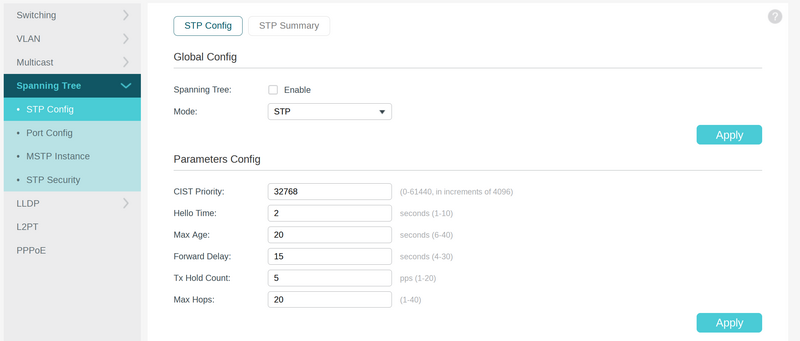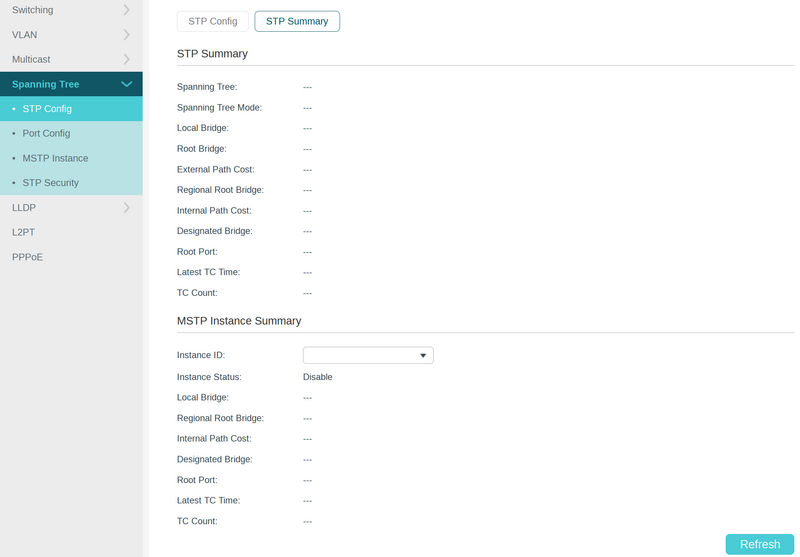T2600G/L2/STP
STP (Spanning Tree Protocol) is a Layer 2 protocol that prevents loops in the network. It helps to ensure a loop-free topology both initially or after topology changes by changing the state of ports. STP can protect the network from broadcast storms and the damage to MAC address. RSTP (Rapid Spanning Tree Protocol) and MSTP (Multiple Spanning Tree Protocol) are technological improvements on STP. RSTP provides a much faster speed of spanning tree convergence than STP. MSTP can also provides a faster spanning tree convergence speed and in addition can work with VLANs. With MSTP, different VLANs map to different spanning trees (MST instances) and the traffic is separated into different spanning trees so that MSTP can implement load balancing To configure STP/RSTP:
Step1:
Enable Spanning Tree globally, choose the mode as STP or RSTP, and configure the global parameters.
Step2:
Go to the Spanning Tree > Port Config page, enable spanning tree for ports, and configure the other port parameters.
To configure MSTP:
Step1:
Enable Spanning Tree globally, choose the mode as STP or RSTP, and configure the global parameters.
Step2:
Go to Spanning Tree > Port Config page, enable spanning tree for ports, and configure the other port parameters.
Step3:
Go to Spanning Tree > MSTP Instance, configure the region and instance parameters.
Global Config
Here you can enable the spanning tree function globally and choose the spanning tree mode.
Spanning Tree
Enable or disable the spanning tree function globally.
Mode
Select the spanning tree mode.
STP
Set the spanning tree mode as STP. It is the basic spanning tree protocol based on IEEE 802.1d.
RSTP
Set the spanning tree mode as RSTP. RSTP has the same function as STP, but it can speed up the spanning tree convergence.
MSTP
Set the spanning tree mode as MSTP. MSTP can work with VLANs and implement load balancing.
Parameters Config
Here you can configure the global parameters for spanning tree.
CIST Priority
Specify the CIST priority for the switch. CIST priority is a parameter used to determine the root bridge for spanning tree. The switch with the lower value has the higher priority. In STP/RSTP, CIST priority is the priority of the switch in spanning tree. The switch with the highest priority will be elected as the root bridge. In MSTP, CISP priority is the priority of the switch in CIST. The switch with the higher priority will be elected as the root bridge in CIST.
Hello Time
Specify the interval between BPDUs' sending. It works with the MAX Age to test the link failures and maintain the spanning tree.
Max Age
Specify the maximum time that the switch can wait without receiving a BPDU before attempting to regenerate a new spanning tree.
Forward Delay
Specify the interval between the port state transition from listening to learning. It is used to prevent the network from causing temporary loops during the regeneration of spanning tree. The interval between the port state transition from learning to forwarding is also the Forward Delay.
Tx Hold Count
Specify the maximum number of BPDU that can be sent in a second.
Max Hops
Specify the maximum BPDU counts that can be forwarded in a MST region. A switch receives BPDU, then decrements the hop count by one and generates BPDUs with the new value. When the hop reaches zero, the switch will discard the BPDU. This value can control the scale of the spanning tree in the MST region.
STP Config
STP Config
STP Summary
Port Config
A spanning tree is generated by comparing multiple parameters between different switches and ports and determining their roles. For a targeted topology, it is necessary to specify these parameters manually. Port Config
Here you can view and configure the parameters of the ports.
Port
Select one or more ports to configure.
Status
Enable or disable spanning tree function on the desired port.
Priority
Specify the Priority for the desired port. The value should be an integral multiple of 16, ranging from 0 to 240. Ports with lower values have higher priority. When the root path of the port is the same as other ports', the switch will compare the port priorities and select a root port with the highest priority.
Ext-Path Cost
Enter the value of the external path cost. The valid values are from 0 to 2000000. The default setting is Auto, which means the port calculates the external path cost automatically according to the port's link speed. For STP/RSTP, external path cost indicates the path cost of the port in spanning tree. The Port with the lowest root path cost will be elected as the root port of the switch. For MSTP, external path cost indicates the path cost of the port in CST.
Int-Path Cost
Enter the value of the internal path cost. The valid values are from 0 to 2000000. The default setting is Auto, which means the port calculates the internal path cost automatically according to the port's link speed. This parameter is only used in MSTP. For MSTP, internal path cost is used to calculate the path cost in IST. The port with the lowest root path cost will be elected as the root port of the switch in IST.
Edge Port
Select Enable to set the port as an edge port. When the topology is changed, the edge port can transit its state from blocking to forwarding directly. For the quick generation of the spanning tree, it is recommended to set the ports that are connected to the end devices as edge ports.
P2P Link
Select the status of the P2P (Point-to-Point) link to which the ports are connected. During the regeneration of the spanning tree, if the port of P2P link is elected as the root port or the designated port, it can transit its state to forwarding directly.
Auto
The switch automatically checks if the port is connected to a P2P link, then sets the status as Open or Closed.
Open(Force)
A port is set as the one that is connected to a P2P link. You should check the link first.
Closed(Force)
A port is set as the one that is not connected to a P2P link. You should check the link first.
MCheck
Perform MCheck operations on the port. If a port on an RSTP-enabled/MSTP-enabled device is connected to an STP-enabled device, the port will switch to STP compatible mode and send packets in STP format. MCheck is used to switch the mode of the port back to RSTP/MSTP after the port is disconnected from the STP-enabled device. The MCheck function will take effect immediately after clicking Apply. Every time the situation above happens, you need to do the MCheck action manually.
Port Mode
Displays the spanning tree mode of the port.
Port Role
Displays the role that the port plays in the spanning tree.
Root Port
Indicates that the port is the root port in the spanning tree. It has the lowest path cost from the root bridge to this switch and is used to communicate with the root bridge.
Designated Port
Indicates that the port is the designated port in the spanning tree. It has the lowest path cost from the root bridge to this physical network segment and is used to forward data for the corresponding network segment.
Alternate Port
Indicates that the port is the alternate port in the spanning tree. It is the backup of the root port or master port.
Backup Port
Indicates that the port is the backup port in the spanning tree. It is the backup of the designated port.
Master Port
Indicates the port provides the lowest root path cost from the region to the root bridge in CIST. In CIST, each region is regarded as a switch, and the master port is the root port of the corresponding region.
Disabled
Indicates that the port is not participating in the spanning tree.
Port Status
Displays the port status.
Forwarding
The port receives and sends BPDUs, and forwards user traffic.
Learning
The port receives and sends BPDUs. It also receives user traffic, but doesn't forward the traffic.
Blocking
The port only receives and sends BPDUs.
Disconnected
The port is enabled with spanning tree function but not connected to any device.
LAG
Displays the LAG that the port belongs to.
MSTP Instance
MSTP divides the spanning tree into multiple regions and instances to cooperate with different VLANs. The spanning tree consists of multiple MST regions (Multiple Spanning Tree regions) and the MST regions are distinguished by region configuration and VLAN-Instance mapping configuration. Region Config
Here you can configure the region name and the revision level for the MST region.
Region Name
Specify the name for an MST region. It contains 32 characters at most.
Revision Level
Enter the revision level number.


